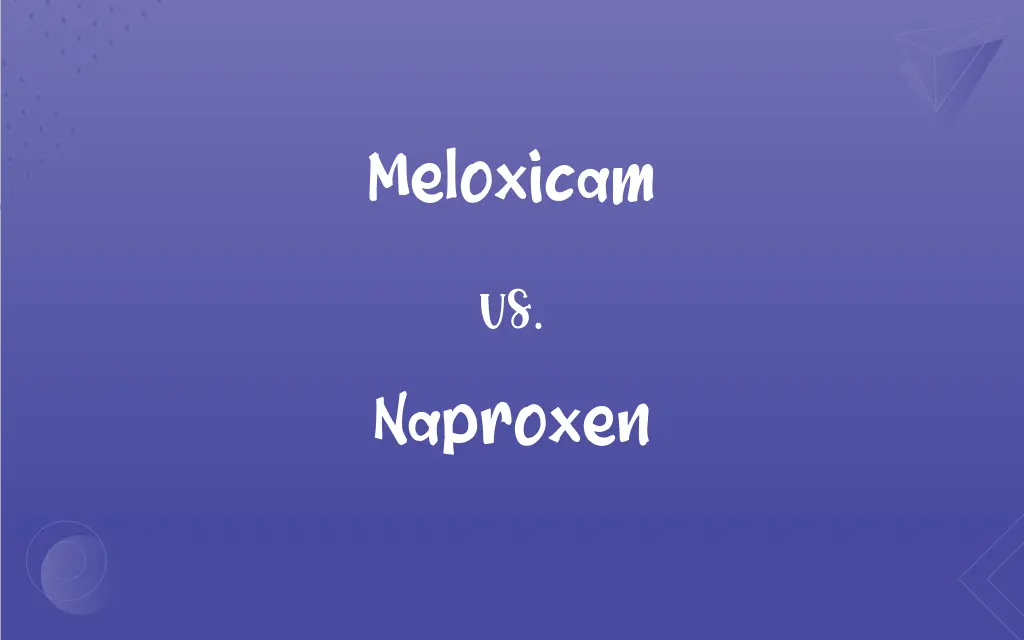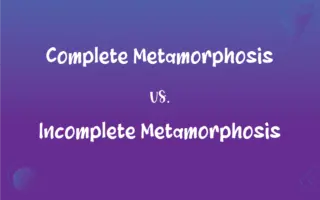Meloxicam vs. Naproxen: What's the Difference?
Edited by Aimie Carlson || By Harlon Moss || Updated on October 26, 2023
Meloxicam and naproxen are both nonsteroidal anti-inflammatory drugs (NSAIDs), but they differ in their specific uses, dosing, and side effects.

Key Differences
Meloxicam and naproxen belong to the category of nonsteroidal anti-inflammatory drugs (NSAIDs). Both are used to treat pain and inflammation stemming from various conditions. However, the specific ailments they treat may vary.
Meloxicam, often sold under the brand name Mobic, is generally prescribed for osteoarthritis and rheumatoid arthritis. Naproxen, on the other hand, which can be found under brand names like Aleve or Naprosyn, is used for a broader range of conditions, including arthritis, ankylosing spondylitis, tendinitis, and menstrual pain.
Regarding their administration, meloxicam is usually taken once daily due to its longer half-life. Naproxen, conversely, might be taken more than once a day depending on the condition being treated and its formulation.
Both meloxicam and naproxen can offer relief from pain and reduce inflammation. But, like all NSAIDs, they come with potential side effects. Some common ones include gastrointestinal issues, such as ulcers or bleeding. However, the specific risk profiles and side effect potentials differ between the two.
When choosing between meloxicam and naproxen, physicians take into account the patient's specific condition, potential drug interactions, and the patient's overall health profile. Both are effective, but their suitability depends on individual circumstances.
ADVERTISEMENT
Comparison Chart
Common Uses
Osteoarthritis, rheumatoid arthritis
Arthritis, tendinitis, menstrual pain, ankylosing spondylitis
Brand Names
Mobic
Aleve, Naprosyn
Dosing Frequency
Usually once daily
Depending on condition and formulation, possibly more frequent
Potential Side Effects
Gastrointestinal issues, cardiovascular risks
Gastrointestinal issues, cardiovascular risks, kidney problems
Over-the-counter Variant
No
Yes (e.g., Aleve)
ADVERTISEMENT
Meloxicam and Naproxen Definitions
Meloxicam
Used to treat pain and inflammation from specific joint diseases.
With meloxicam, he noticed a decrease in his joint inflammation.
Naproxen
An NSAID for a range of pain and inflammation conditions.
He used naproxen to alleviate his tendinitis symptoms.
Meloxicam
A prescription NSAID primarily for arthritis-related pain.
She started taking meloxicam for her osteoarthritis pain.
Naproxen
Effective against conditions like arthritis and menstrual cramps.
Her doctor recommended naproxen for her menstrual pain.
Meloxicam
Often available under the brand name Mobic.
She refilled her Mobic prescription, which contains meloxicam.
Naproxen
Available both by prescription and over-the-counter.
For his mild pain, he bought over-the-counter naproxen.
Meloxicam
An anti-inflammatory drug with analgesic properties.
After the diagnosis, her doctor prescribed meloxicam for relief.
Naproxen
Known for its broad spectrum of pain-relieving properties.
For diverse pains, naproxen was her go-to choice.
Meloxicam
A once-daily medication due to its prolonged half-life.
She preferred meloxicam over others because of its once-a-day dosage.
Naproxen
Often sold under brands like Aleve or Naprosyn.
She found relief using Aleve, which contains naproxen.
Meloxicam
A nonsteroidal anti-inflammatory drug, C14H13N3O4S, used to treat osteoarthritis and rheumatoid arthritis.
Naproxen
A nonsteroidal anti-inflammatory drug, C14H14O3, used to treat fever and pain.
Meloxicam
(pharmaceutical drug) A non-steroidal anti-inflammatory drug of the oxicam class (trademark Mobic), used to relieve the symptoms of arthritis and primary dysmenorrhea and as an analgesic.
Naproxen
(pharmacology) A certain non-steroidal anti-inflammatory drug that inhibits the COX-1 and COX-2 enzymes and thereby reduces pain, fever, inflammation, and stiffness.
Naproxen
A nonsteroidal anti-inflammatory drug (trade name Naprosyn) used in the treatment of arthritis and musculoskeletal inflammation and moderate pain
FAQs
Can a sentence be just a phrase?
No, a complete sentence requires at least one clause.
What's the primary distinction between a phrase and a clause?
A phrase lacks a subject and verb pairing, while a clause has both.
Do all clauses convey complete thoughts?
No, only independent clauses do; dependent clauses don't stand alone.
What's an example of a verb phrase?
"Have been running" is a verb phrase.
Is "the quick brown fox" a clause or phrase?
It's a phrase, specifically a noun phrase.
Can a clause be part of a phrase?
Yes, a clause can be nested within a larger phrase.
How is a noun phrase different from a noun clause?
A noun phrase centers around a noun, while a noun clause has a subject and verb but functions as a noun.
What differentiates an independent from a dependent clause?
An independent clause can stand alone as a sentence, while a dependent clause can't.
Can a sentence begin with a phrase?
Yes, for example, "In the garden, the flowers bloomed."
Are there verb clauses?
No, but there are verb phrases.
Is "in the morning" a phrase or a clause?
It's a phrase, specifically a prepositional phrase.
Can a sentence have multiple phrases and clauses?
Absolutely, many complex sentences contain several of each.
Which is longer, a phrase or a clause?
Neither inherently; both can be short or long, depending on content.
Why are understanding phrases and clauses important?
They're foundational to sentence structure, aiding in effective communication.
Are idioms considered phrases?
Yes, idioms like "kick the bucket" are types of phrases.
Can a phrase become a clause?
If you add a subject and verb, a phrase can be expanded into a clause.
Why are dependent clauses also called subordinate clauses?
They're "subordinate" because they rely on main clauses to make sense.
How do adverbial clauses differ from adverbial phrases?
Adverbial clauses have a subject and verb; adverbial phrases don't.
What's a relative clause?
A type of dependent clause introduced by relative pronouns, e.g., "who" or "which."
Can clauses and phrases be combined?
Yes, often a single sentence will contain multiple phrases and clauses.
About Author
Written by
Harlon MossHarlon is a seasoned quality moderator and accomplished content writer for Difference Wiki. An alumnus of the prestigious University of California, he earned his degree in Computer Science. Leveraging his academic background, Harlon brings a meticulous and informed perspective to his work, ensuring content accuracy and excellence.
Edited by
Aimie CarlsonAimie Carlson, holding a master's degree in English literature, is a fervent English language enthusiast. She lends her writing talents to Difference Wiki, a prominent website that specializes in comparisons, offering readers insightful analyses that both captivate and inform.































































